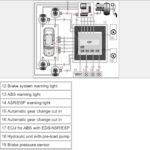This guide provides a detailed procedure for adjusting the valves and engine injectors on a Volvo D13 engine. Proper valve and injector adjustment is crucial for optimal engine performance, fuel efficiency, and longevity. This information is based on Volvo Trucks North America Service Bulletin 214-93, Release 03, November 2014.
Special Tools Required
Before beginning the adjustment process, gather the necessary special tools. Refer to Volvo’s Tool Information, Function Group 08 for ordering instructions:
- Flywheel Turning Tool: 88800014 (W2005941)
- Feeler Gauge Set: 85111377 or 88880053 (W0000416)
- 2.5mm Feeler Gauge: 88880052 (included in set 88880053) (W2055377)
- Shim Kit (for engines with shims): 3949521
Safety Precautions
- Training and Certification: This procedure requires specialized training and certification. Consult your supervisor for training if needed.
- Parking Brake and Wheel Chocks: Engage the parking brake, place the transmission in neutral, and chock the wheels before working on the vehicle.
- Service Literature and Tools: Always consult the official Volvo service literature and use the correct tools for this procedure.
Valve and Injector Adjustment Procedure
1. Prepare the Engine:
- Remove the valve cover.
- Remove the plug from the flywheel housing and install the flywheel turning tool (88800014).
- Release the engine brake rocker arm spring tension by removing the fasteners retaining the leaf springs. Remove the leaf springs.
2. Camshaft Markings:
- Without Engine Brake: Markings 1-6 on the camshaft apply to intake valves, exhaust valves, and injectors.
- With Engine Brake: Markings 1-6 apply to intake valves and injectors. Markings E1-E6 apply to exhaust valves. Refer to the service bulletin for a detailed table of camshaft position and corresponding valve/injector adjustments.
3. Intake Valve Adjustment:
- Rotate the engine using the flywheel turning tool to align the intake valve mark on the camshaft with the mark on the bearing cap. Always rotate the engine in its normal direction of operation.
- With a cold engine (below 140°F), check the intake valve clearance using a feeler gauge (0.20 ± 0.05 mm).
- Adjust the clearance by loosening the rocker arm lock nut and adjusting the plunger if necessary.
- Tighten the lock nut to 38 ± 4 Nm while holding the adjusting screw. Recheck the clearance.
4. Injector Adjustment:
- Loosen the injector rocker arm lock nut and back off the adjusting screw until it loses contact.
- Adjust the rocker arm to zero clearance (no spring compression).
- Tighten the adjusting screw an additional four flats (240 degrees) clockwise.
- Tighten the lock nut to 52 ± 4 Nm.
5. Exhaust Valve Adjustment (Without Engine Brake):
- Check the exhaust valve clearance using a feeler gauge (0.80 ± 0.05 mm).
- Adjust as needed, following the same procedure as the intake valve adjustment.
6. Exhaust Valve Adjustment (With Engine Brake):
- Rotate the engine to the corresponding “E” mark for the exhaust valve.
- Check and adjust the clearance (1.00 ± 0.05 mm) using shims (if applicable) or by adjusting the plunger. Refer to the service bulletin for detailed shim instructions.
- Adjust the engine brake rocker arm to the correct clearance (2.5 ± 0.07 mm). This involves preloading the mechanism and ensuring proper clearance between the rocker arm roller and the cam lobe.
7. Final Steps:
- Repeat the procedures for all cylinders.
- Clean the valve cover mating surface.
- Install the valve cover.
- For engines with an engine brake, install the leaf springs and tighten the retaining screws.
- Run the engine to operating temperature and allow it to idle for 5 minutes for cylinder balancing.
Conclusion
This guide provides a comprehensive overview of the Volvo D13 valve and injector adjustment process. Always refer to the official Volvo service bulletin for complete instructions and specific torque values. This procedure should only be performed by trained and qualified technicians using the proper tools and safety precautions. Accurate valve and injector adjustment ensures the engine operates at peak performance and efficiency. Consult Volvo’s official documentation for the most up-to-date information.

